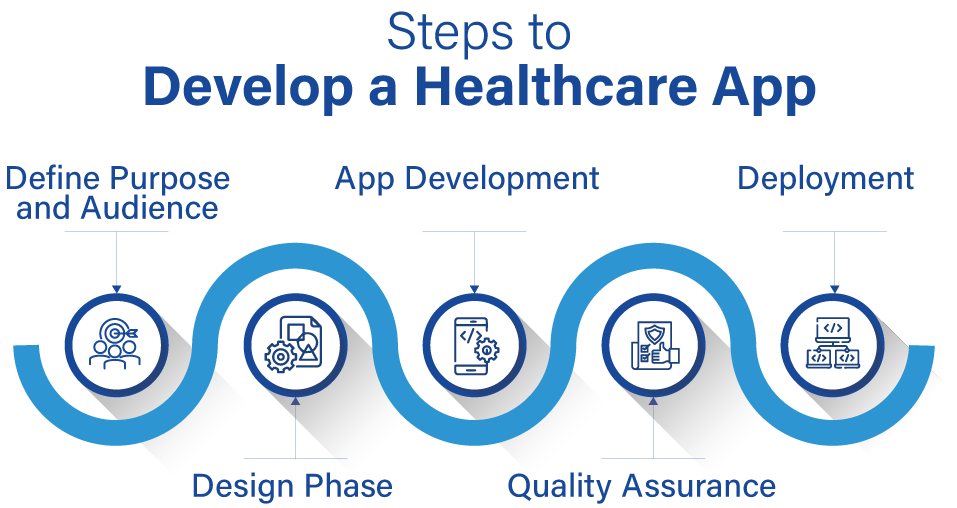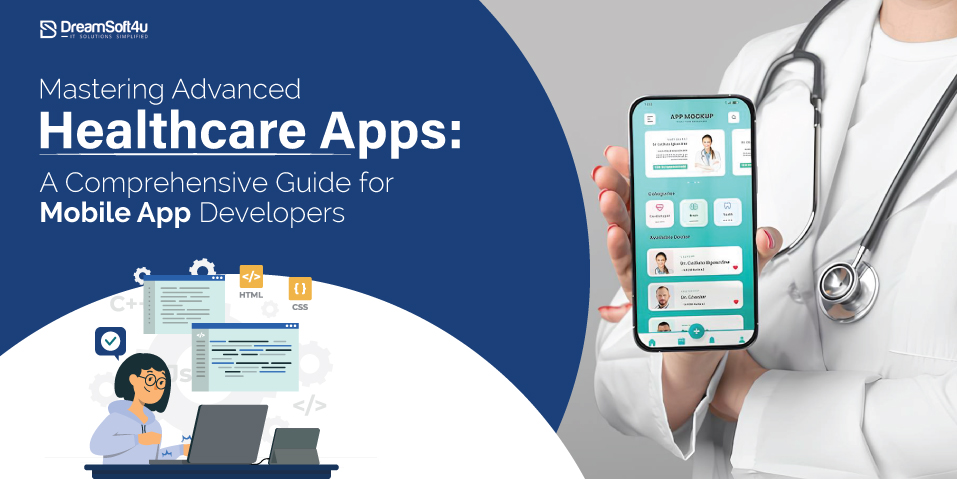In today’s digital age, healthcare apps have become a significant force. They are reshaping how we access and manage our health information. These apps also generate substantial revenue, outpacing many other categories.
For developers, startups, and software providers, this is a lucrative opportunity. In this comprehensive guide, we’ll delve into the figures and facts behind healthcare app development, the latest trends driving innovation, and the unique challenges developers face in this dynamic field.
Table of Contents
ToggleThe Importance of Healthcare Apps
Mobile healthcare apps are changing the game. They make care delivery convenient and hassle-free with features like remote consultations, health tracking, and easy access to medical records. They empower patients, improve communication with doctors, and make healthcare more accessible and efficient, especially in underserved areas.
The market for healthcare apps
- Global mHealth apps market size in 2022: USD 43.5 billion.
- Expected CAGR from 2023 to 2030 for mHealth apps: 11.6%
- Global digital health market size in 2022: USD 211.0 billion.
- The projected growth of the Patient-centric Healthcare App Market from 2022 to 2030: CAGR of 39.1%, reaching $136.4 billion.
- Mobile Medical Apps Market value in 2021: USD 5.37 billion. Expected growth to USD 38.47 billion by 2029 at a CAGR of 27.90%
These figures provide a snapshot of the significant growth and market size in the mhealth app development and digital health sectors.
Trends in healthcare application development
In healthcare app development, important trends include
- AI and ML Integration: AI-powered apps use smart technology to study medical data, offer personalized treatment ideas, and spot health issues early.
- Wearable Tech and IoT: Wearable devices and IoT tech collect real-time health info for constant monitoring. This data blends into apps for easy health tracking and timely help.
- Telehealth Services: The rise of telehealth services within healthcare apps allows users to consult with healthcare professionals remotely, enhancing access to medical care from the comfort of their homes.
- Blockchain for Data Security: The adoption of blockchain technology in healthcare apps ensures secure and tamper-proof storage of sensitive patient data, maintaining privacy and data integrity.
- Mental Health and Wellness Apps: The proliferation of mental health and wellness apps addresses the growing need for stress management, meditation, and emotional well-being, providing users with tools to support their mental health
Key features of successful healthcare apps
Successful healthcare apps share some common key features that contribute to their usability and effectiveness. These include:
- User-Friendly Interfaces: Easy-to-use designs make navigation and interaction straightforward for all users.
- Secure Data Handling: Robust security ensures safe storage and transmission of sensitive data.
- EHR System Integration: Seamless connection to electronic health records streamlines access to medical information.
- Personalized Health Tracking: Tailored tracking for individual health needs.
- Real-Time Communication: Options for immediate contact with healthcare professionals.
- Gamification Elements: Incorporating rewards and challenges for user engagement and healthy habits.
- Accessibility Features: Multilingual support and compatibility with various devices and operating systems to reach a wider audience.
Challenges in developing healthcare apps
Developing healthcare apps involves challenges such as:
- Data Security and Privacy: Ensuring sensitive health data is protected, following regulations like HIPAA for patient privacy.
- Interoperability: Making sure apps work smoothly with existing healthcare systems, like EHRs, for seamless data sharing.
- Compatibility: Creating apps that work on different devices and operating systems to reach a broader audience.
To overcome these challenges, mobile app developers need to plan meticulously, follow industry standards, and keep the apps up-to-date.
Steps to develop a healthcare app

Creating a successful healthcare app follows a structured process:
- Define Purpose and Audience: Start by clarifying the app’s mission and who it’s for. Market research helps identify user needs.
- Design Phase: Develop a detailed plan, including wireframes and user flows, to visualize how the app will work and look.
- App Development: Build the app, coding, testing, and fixing any issues along the way.
- Quality Assurance: Rigorous testing ensures the app performs well, is user-friendly, and is secure.
- Deployment: Make the app available on relevant app stores. Continuously gather user feedback for improvements.
Tools and resources for healthcare application development
For healthcare app developers, several tools and resources streamline the development process:
Integrated Development Environments (IDEs):
Android Studio must be your preferred choice for building robust Android applications due to its feature-rich environment. Likewise, utilize Xcode for efficient iOS app development, providing a comprehensive ecosystem.
Cross-Platform Development Frameworks:
Flutter and React Native, facilitate cross-platform app creation, ensuring compatibility with both Android and iOS. This approach significantly minimizes development time.
Health Data Integration Tools:
HealthKit (iOS) and Google Fit (Android). These libraries and APIs make it easy to incorporate health-related data into healthcare apps.
Online Communities and Support:
Platforms and technology providers offer valuable online communities, forums, and documentation to assist healthcare mobile app developers throughout the app development process.
Custom healthcare software development vs. pre-built solutions
In healthcare application development, developers face a choice between custom software and pre-built solutions. Custom development involves creating an app from scratch, and tailoring it to the specific needs of a healthcare provider. It offers maximum flexibility but demands more time and resources.
On the other hand, pre-built solutions, such as electronic health record systems, come with ready-made features that can be adjusted to some extent. They allow for quicker deployment but may not offer the same level of customization and scalability as custom-built apps.
| Aspect | Custom Software Development | Pre-Built Solutions |
| Customization | Highly customizable | Limited customization |
| Development Time | More time-intensive | Quicker deployment |
| Resource Requirement | More resources needed | Fewer resources required |
| Specific Requirements | Ideal for unique needs | Suited for common features |
| Scalability | Highly scalable | May have scalability limits |
| Cost | Higher development costs | Lower initial costs |
| Maintenance and Updates | Greater control over updates | Updates managed by provider |
| Flexibility | Offers maximum flexibility | Less flexible, but easier to start |
| Use Cases | Complex, specialized apps | General healthcare functions |
| Implementation Complexity | May require a skilled team | Easier for non-technical users |
Best practices in healthcare software development
For successful healthcare software development, consider these key points and best practices:
- User-Centered Design: Focus on the needs and preferences of end-users for creating user-friendly healthcare apps.
- Usability Testing: Test the app with real users to ensure it’s intuitive and effective.
- Security and Privacy: Prioritize the protection of data and adhere to industry standards and regulations.
- Regular Updates: Keep the app up-to-date with bug fixes, security improvements, and compatibility adjustments.
- Cloud Integration: Consider utilizing cloud services for scalability and data accessibility.
- Data Exchange Protocols: Implement secure and standardized data exchange methods for interoperability
Electronic data exchange in healthcare apps
To ensure smooth electronic data exchange in healthcare apps, consider these key points:
Interoperability Standards:
Use standards like HL7 and FHIR for structured data sharing. Example: A physician’s EHR system generates a shareable patient record using HL7’s CDA format.
APIs and Data Integration:
Employ RESTful APIs and integration platforms like MuleSoft for seamless communication with EMR systems. This enables apps to access patient records and lab results.
Data Availability and Accessibility:
Store data in the cloud for remote access. This allows healthcare professionals to securely retrieve patient information through the app, improving care coordination.
Compliance with Standards:
Follow FHIR standards during telehealth app development. This way you will ensure consistent and interpretable data sharing between the app and healthcare systems.
Secure Data Transmission:
Encrypt data in transit with SSL/TLS. For instance, SSL/TLS ensures patient health data remains confidential when transmitted from the app to a central server.
The Future of Healthcare App Development
Healthcare apps are becoming more advanced and personalized thanks to new technologies. Here’s how some of these technologies are used:
- Artificial Intelligence (AI): AI can make healthcare apps smarter. AI is used in apps like Aidoc and Zebra Medical Vision to analyze medical images and help doctors diagnose diseases.
- Machine Learning (ML): ML can help healthcare apps learn from data and improve over time. Apps like Calm and Headspace use ML to track moods and recommend meditation activities.
- Augmented Reality (AR): AR can make healthcare apps more interactive. The AccuVein app uses AR to help healthcare providers locate veins more accurately for injections4.
- Blockchain: Blockchain can make healthcare apps more secure. Companies like Akiri are using blockchain to protect the transportation of patient health data.
As more people start using healthcare apps, developers need to keep up with these technological trends to create apps that are not only innovative but also have a positive impact on healthcare.
Key Takeaways
In a rapidly evolving landscape, healthcare apps have emerged as a promising and lucrative sector. Successful development requires a deep understanding of industry dynamics, user demands, and the integration of cutting-edge technologies like AI, ML, AR, and blockchain. By adhering to best practices, following industry standards, and prioritizing user experience, developers can create impactful healthcare apps.
Have a healthcare app idea? Contact us for expert healthcare software development services and unlock the full potential of your application.
FAQs
Q. How many projects have you completed so far?
We have completed over 200+ healthcare app projects, ranging from telehealth solutions to personalized wellness apps. Our 19+ years of experience make us a leading mobile app development services provider.
Q. What is the ideal team size for a healthcare app project?
The team size can vary based on the project’s complexity, but a typical healthcare app development team includes developers, UI/UX designers, quality assurance experts, and project managers.
Q. How many hours of project time should I expect?
The project timeline depends on the app’s features and complexity. On average, a healthcare app may take 3 to 12 months to develop.
Q. What are the engagement models you offer?
We offer flexible engagement models, including fixed-price, time and materials, and dedicated team models, to suit your project requirements and budget.
Q. What technologies does your team employ for healthcare app development?
Our tech stack includes Swift and Kotlin for native app development, PostgreSQL and Firebase for secure data storage, and cross-platform frameworks like Flutter and React Native. We integrate health data using HealthKit and Google Fit while adhering to data exchange standards like HL7 and FHIR for privacy and interoperability.






















